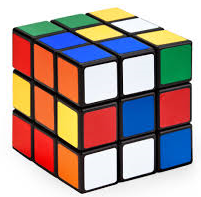
Rubik's Cube is a 3-D combination puzzle invented in 1974 by Hungarian sculptor and professor of architecture Ernő Rubik Originally called the Magic Cube,the puzzle was licensed by Rubik to be sold by Ideal Toy Corp. in 1980 via businessman Tibor Laczi and Seven Towns founder Tom Kremer, and won the German Game of the Year special award for Best Puzzle that year. As of January 2009, "350 million" cubes had been sold worldwide making it the world's top-selling puzzle game. It is widely considered to be the world's best-selling toy.
In the mid-1970s, Ernő Rubik worked at the Department of Interior Design at the Academy of Applied Arts and Crafts in Budapest.Although it is widely reported that the Cube was built as a teaching tool to help his students understand 3D objects, his actual purpose was solving the structural problem of moving the parts independently without the entire mechanism falling apart. He did not realise that he had created a puzzle until the first time he scrambled his new Cube and then tried to restore it. Rubik applied for a patent in Hungary for his "Magic Cube" on 30 January 1975 , and HU170062 was granted later that year.
The first test batches of the Magic Cube were produced in late 1977 and released in Budapest toy shops. Magic Cube was held together with interlocking plastic pieces that prevented the puzzle being easily pulled apart, unlike the magnets in Nichols's design. With Ernő Rubik's permission, businessman Tibor Laczi took a Cube to Germany's Nuremberg Toy Fair in February 1979 in an attempt to popularise it.It was noticed by Seven Towns founder Tom Kremer and they signed a deal with Ideal Toys in September 1979 to release the Magic Cube worldwide.Ideal wanted at least a recognisable name to trademark; of course, that arrangement put Rubik in the spotlight because the Magic Cube was renamed after its inventor in 1980. The puzzle made its international debut at the toy fairs of London, Paris, Nuremberg and New York in January and February 1980.
After its international debut, the progress of the Cube towards the toy shop shelves of the West was briefly halted so that it could be manufactured to Western safety and packaging specifications. A lighter Cube was produced, and Ideal decided to rename it. "The Gordian Knot" and "Inca Gold" were considered, but the company finally decided on "Rubik's Cube", and the first batch was exported from Hungary in May 1980.
On the original classic Rubik's Cube, each of the six faces was covered by nine stickers, each of one of six solid colours: white, red, blue, orange, green, and yellow. The current version of the cube has been updated to coloured plastic panels instead, which prevents peeling and fading. In currently sold models, white is opposite yellow, blue is opposite green, and orange is opposite red, and the red, white and blue are arranged in that order in a clockwise arrangement. On early cubes, the position of the colours varied from cube to cube.An internal pivot mechanism enables each face to turn independently, thus mixing up the colours. For the puzzle to be solved, each face must be returned to have only one colour. Similar puzzles have now been produced with various numbers of sides, dimensions, and stickers, not all of them by Rubik.
Although the Rubik's Cube reached its height of mainstream popularity in the 1980s, it is still widely known and used. Many speedcubers continue to practice it and similar puzzles; they also compete for the fastest times in various categories. Since 2003, the World Cube Association, the Rubik's Cube's international governing body, has organised competitions worldwide and recognise world records.
Although the Rubik's Cube reached its height of mainstream popularity in the 1980s, it is still widely known and used. Many speedcubers continue to practice it and similar puzzles; they also compete for the fastest times in various categories. Since 2003, the World Cube Association, the Rubik's Cube's international governing body, has organised competitions worldwide and recognise world records.
